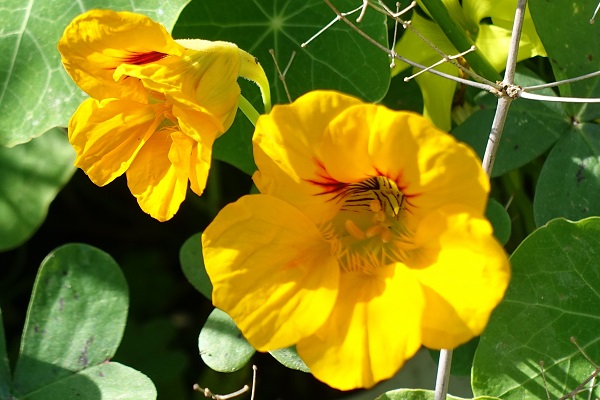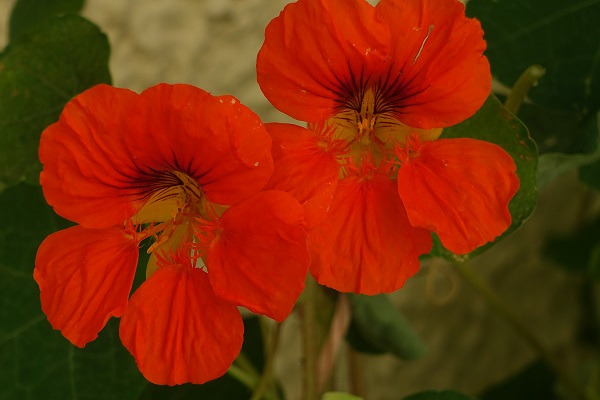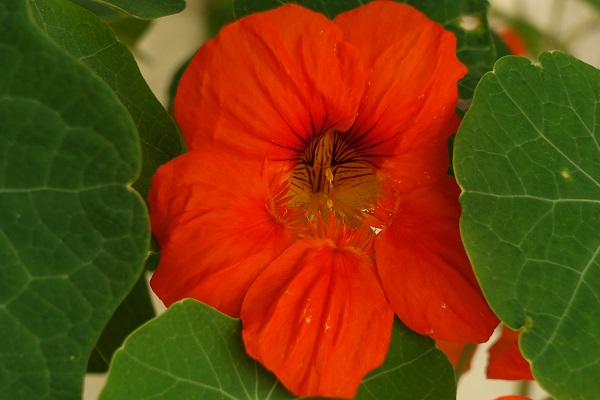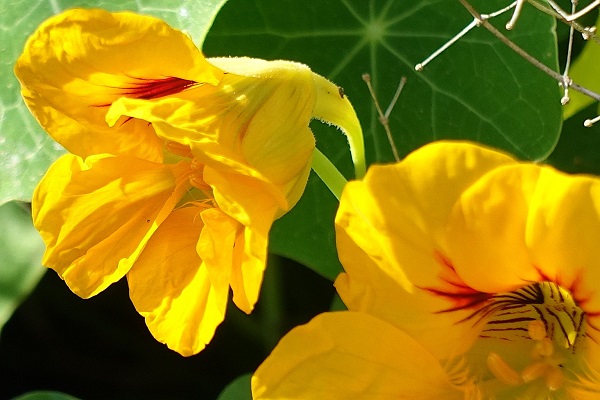Garden nasturtium, Indian cress,
Hebrew: חונק הדוב ,כובע הנזיר, Arabic: كبوسين كبير
| Scientific name: | Tropaeolum majus L. | |
| Synonym name: | Cardamindum majus (L.) Moench, Nasturtium indicum Garsault, Tropaeolum elatum Salisb., Tropaeolum hortense Sparre, Tropaeolum hybridum L., Tropaeolum pinnatum Andrews, Tropaeolum quinquelobum Bergius, Trophaeum majus (L.) Kuntze | |
| Common name: | Garden nasturtium, Indian cress, nasturtium, tall nasturtium | |
| Hebrew name: | חונק הדוב ,כובע הנזיר | |
| Arabic name: | كبوسين كبير | |
| Nederlandse naam: | Oost-Indische kers | |
| Family: | Tropaeolaceae, Nasturtium family, טרופאאוליים |

|
| Life form: | Glabrous annual or perennial | |
| Stems: | 20–40 cm (8–16 in.). Stem usually twining. | |
| Leaves: | Alternate, 4-15cm, peltate, orbicular | |
| Inflorescence: | Solitary in axils | |
| Flowers: | Hermaphrodite, corolla irregular, orange, or red to yellow, or parti-colored; sepals 5, the dorsal produced into a spur of 2-4cm, straight; petals 5, clawed, limb of petal orbicular; 3 lower petals ciliate at base; stamens 8; ovary 3-locular | |
| Fruits / pods: | 3-sectioned schizocarp | |
| Flowering Period: | January, February, March, April, May | |
| Habitat: | Ornamental, sometimes as escape from cultivation; disturbed habitats | |
| Distribution: | Mediterranean Woodlands and Shrublands | |
| Chorotype: | South America - Peru, Ecuador | |
| Summer shedding: | Ephemeral |

Derivation of the botanical name: Tropaeolum, named by Linnaeus, from Greek tropaion "trophy," the plant growing on a post reminded him of a classical trophy with round shields and golden helmets such as those hung as a sign of victory on a battlefield (ref. genus Tropaeolum) Linnaeus was reminded of this by the plant as the round leaves resembled shields and the flowers, blood-stained helmets. majus, bigger, larger.
Sometimes imported plants from different countries become invasive species imported to the country. In Israel such species include Oxalis pes-caprae, Tropaeolum majus (Nasturtium), Lantana camara and more. The flowers of Tropaeolum majus L. are mentioned as edible products in old Spanish writings from the 15-16th century. José Quer y Martínez (1695–1764), a Spanish doctor and botanist, calls Tropaeolum majus of Linnaeus, Cardamindum ampliori-a Tournefortian determination. He writes: "This plant, is grown in pots and containers in the gardens of Madrid. It came to Spain from Peru by the hands of our discoverers, where it grows in abundance inmoist and swampy te ains...." All parts of the plant appear to be antobiotic. 

|